Analyzing UK Monetary and Fiscal Policy: Influencing GDP and Prices
VerifiedAdded on 2023/06/18
|9
|2714
|113
Report
AI Summary
This report provides an analysis of monetary and fiscal policy, focusing on their implementation and influence on GDP and price levels, particularly within the context of the UK economy. It details how the Bank of England implements monetary policy through interest rates and other tools to manage money supply and stabilize the economic cycle. The report also explains how fiscal policy, involving government spending and taxation, is used to monitor and influence the economy, including adjustments to stimulate growth or control inflation. Furthermore, it discusses the role of fiscal policy in mitigating economic downturns and ensuring sustainable growth in the UK, highlighting the importance of balancing short-term measures with long-term initiatives and the potential impacts of taxation and government spending on economic recovery.
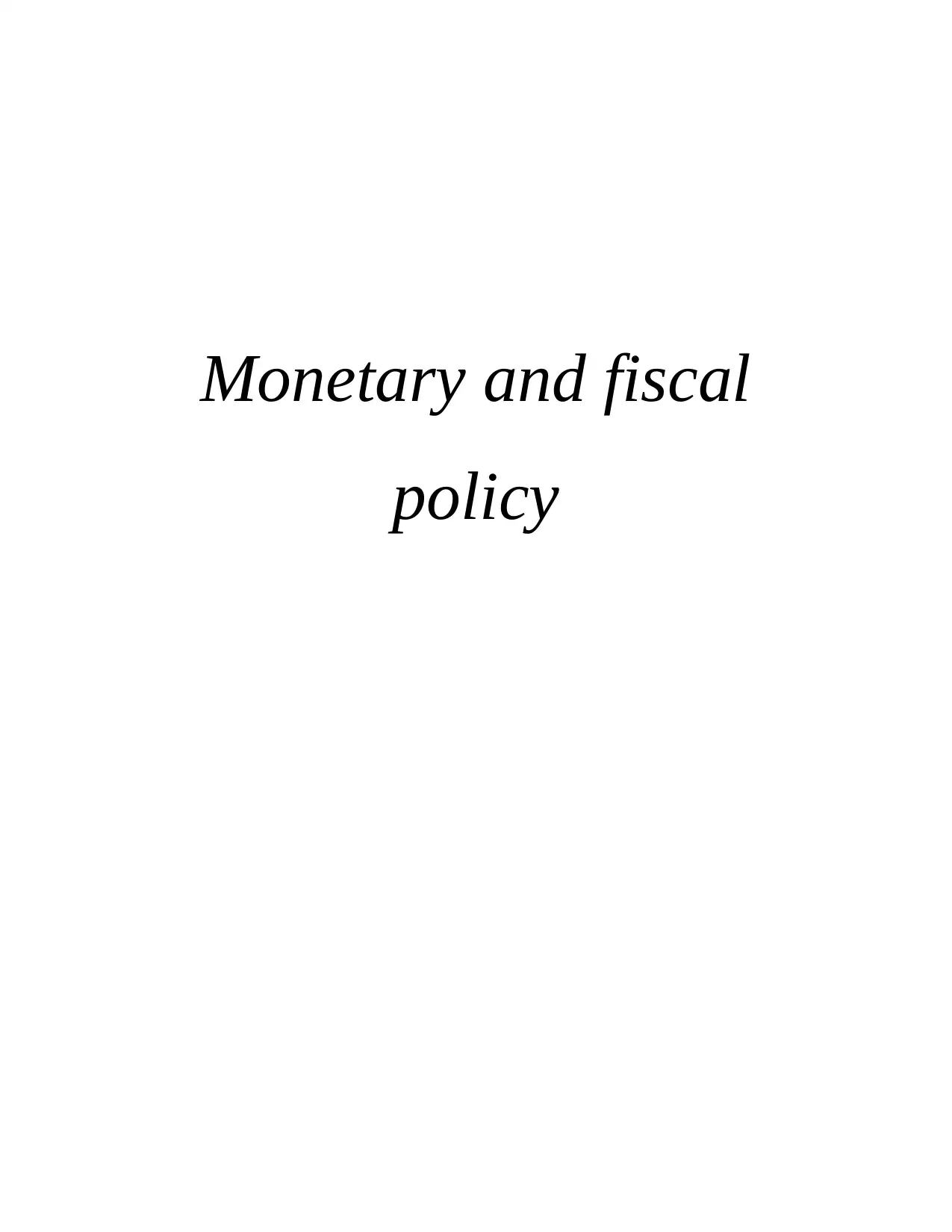
Monetary and fiscal
policy
policy
Paraphrase This Document
Need a fresh take? Get an instant paraphrase of this document with our AI Paraphraser

Contents
Contents...........................................................................................................................................2
INTRODUCTION...........................................................................................................................1
MAIN BODY..................................................................................................................................1
Explanation of how monetary and fiscal policy is implemented and how they can be used to
influence GDP and the price level...............................................................................................1
Whether fiscal policy remain key policy instrument in UK in near future.................................4
CONCLUSION................................................................................................................................5
REFERENCES................................................................................................................................7
Contents...........................................................................................................................................2
INTRODUCTION...........................................................................................................................1
MAIN BODY..................................................................................................................................1
Explanation of how monetary and fiscal policy is implemented and how they can be used to
influence GDP and the price level...............................................................................................1
Whether fiscal policy remain key policy instrument in UK in near future.................................4
CONCLUSION................................................................................................................................5
REFERENCES................................................................................................................................7
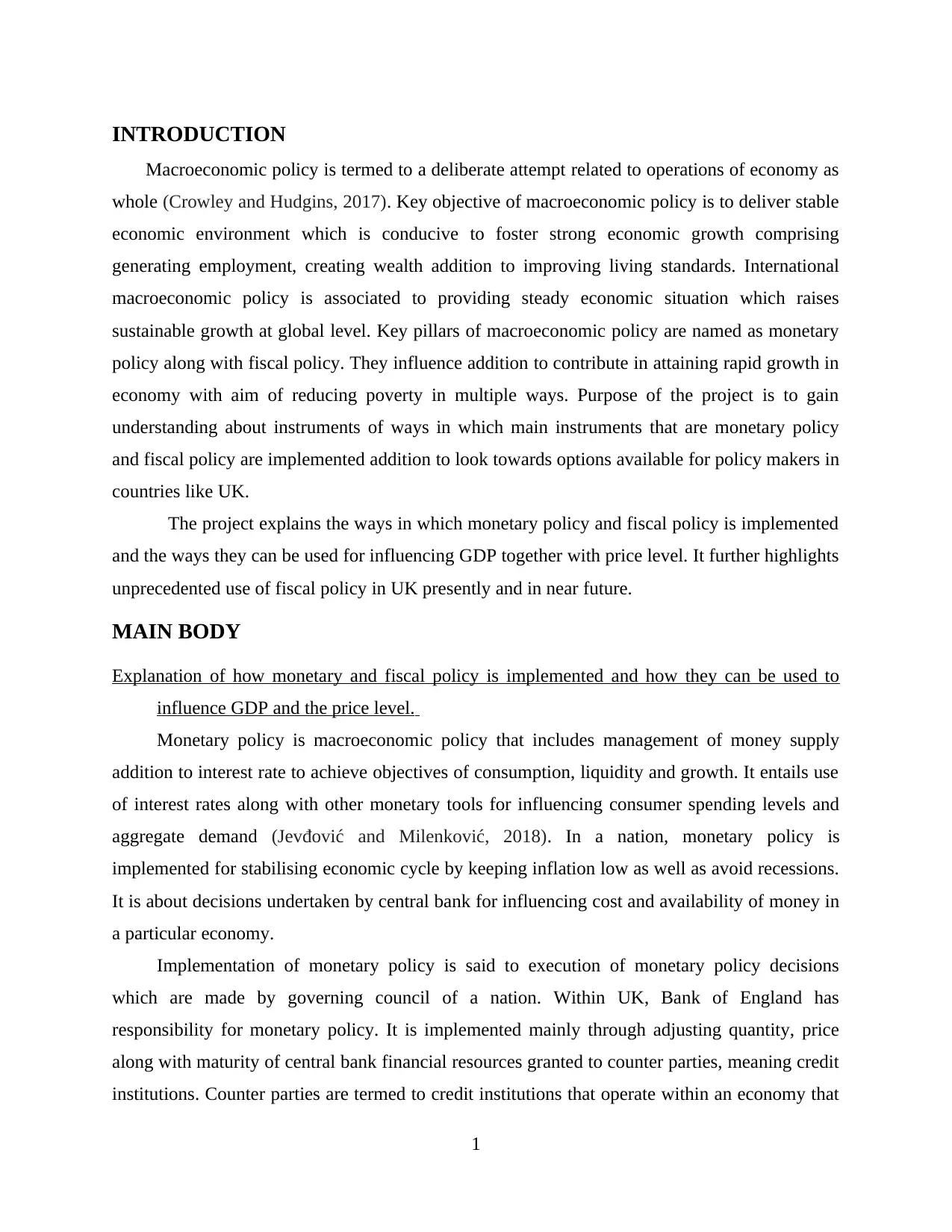
INTRODUCTION
Macroeconomic policy is termed to a deliberate attempt related to operations of economy as
whole (Crowley and Hudgins, 2017). Key objective of macroeconomic policy is to deliver stable
economic environment which is conducive to foster strong economic growth comprising
generating employment, creating wealth addition to improving living standards. International
macroeconomic policy is associated to providing steady economic situation which raises
sustainable growth at global level. Key pillars of macroeconomic policy are named as monetary
policy along with fiscal policy. They influence addition to contribute in attaining rapid growth in
economy with aim of reducing poverty in multiple ways. Purpose of the project is to gain
understanding about instruments of ways in which main instruments that are monetary policy
and fiscal policy are implemented addition to look towards options available for policy makers in
countries like UK.
The project explains the ways in which monetary policy and fiscal policy is implemented
and the ways they can be used for influencing GDP together with price level. It further highlights
unprecedented use of fiscal policy in UK presently and in near future.
MAIN BODY
Explanation of how monetary and fiscal policy is implemented and how they can be used to
influence GDP and the price level.
Monetary policy is macroeconomic policy that includes management of money supply
addition to interest rate to achieve objectives of consumption, liquidity and growth. It entails use
of interest rates along with other monetary tools for influencing consumer spending levels and
aggregate demand (Jevđović and Milenković, 2018). In a nation, monetary policy is
implemented for stabilising economic cycle by keeping inflation low as well as avoid recessions.
It is about decisions undertaken by central bank for influencing cost and availability of money in
a particular economy.
Implementation of monetary policy is said to execution of monetary policy decisions
which are made by governing council of a nation. Within UK, Bank of England has
responsibility for monetary policy. It is implemented mainly through adjusting quantity, price
along with maturity of central bank financial resources granted to counter parties, meaning credit
institutions. Counter parties are termed to credit institutions that operate within an economy that
1
Macroeconomic policy is termed to a deliberate attempt related to operations of economy as
whole (Crowley and Hudgins, 2017). Key objective of macroeconomic policy is to deliver stable
economic environment which is conducive to foster strong economic growth comprising
generating employment, creating wealth addition to improving living standards. International
macroeconomic policy is associated to providing steady economic situation which raises
sustainable growth at global level. Key pillars of macroeconomic policy are named as monetary
policy along with fiscal policy. They influence addition to contribute in attaining rapid growth in
economy with aim of reducing poverty in multiple ways. Purpose of the project is to gain
understanding about instruments of ways in which main instruments that are monetary policy
and fiscal policy are implemented addition to look towards options available for policy makers in
countries like UK.
The project explains the ways in which monetary policy and fiscal policy is implemented
and the ways they can be used for influencing GDP together with price level. It further highlights
unprecedented use of fiscal policy in UK presently and in near future.
MAIN BODY
Explanation of how monetary and fiscal policy is implemented and how they can be used to
influence GDP and the price level.
Monetary policy is macroeconomic policy that includes management of money supply
addition to interest rate to achieve objectives of consumption, liquidity and growth. It entails use
of interest rates along with other monetary tools for influencing consumer spending levels and
aggregate demand (Jevđović and Milenković, 2018). In a nation, monetary policy is
implemented for stabilising economic cycle by keeping inflation low as well as avoid recessions.
It is about decisions undertaken by central bank for influencing cost and availability of money in
a particular economy.
Implementation of monetary policy is said to execution of monetary policy decisions
which are made by governing council of a nation. Within UK, Bank of England has
responsibility for monetary policy. It is implemented mainly through adjusting quantity, price
along with maturity of central bank financial resources granted to counter parties, meaning credit
institutions. Counter parties are termed to credit institutions that operate within an economy that
1
⊘ This is a preview!⊘
Do you want full access?
Subscribe today to unlock all pages.

Trusted by 1+ million students worldwide
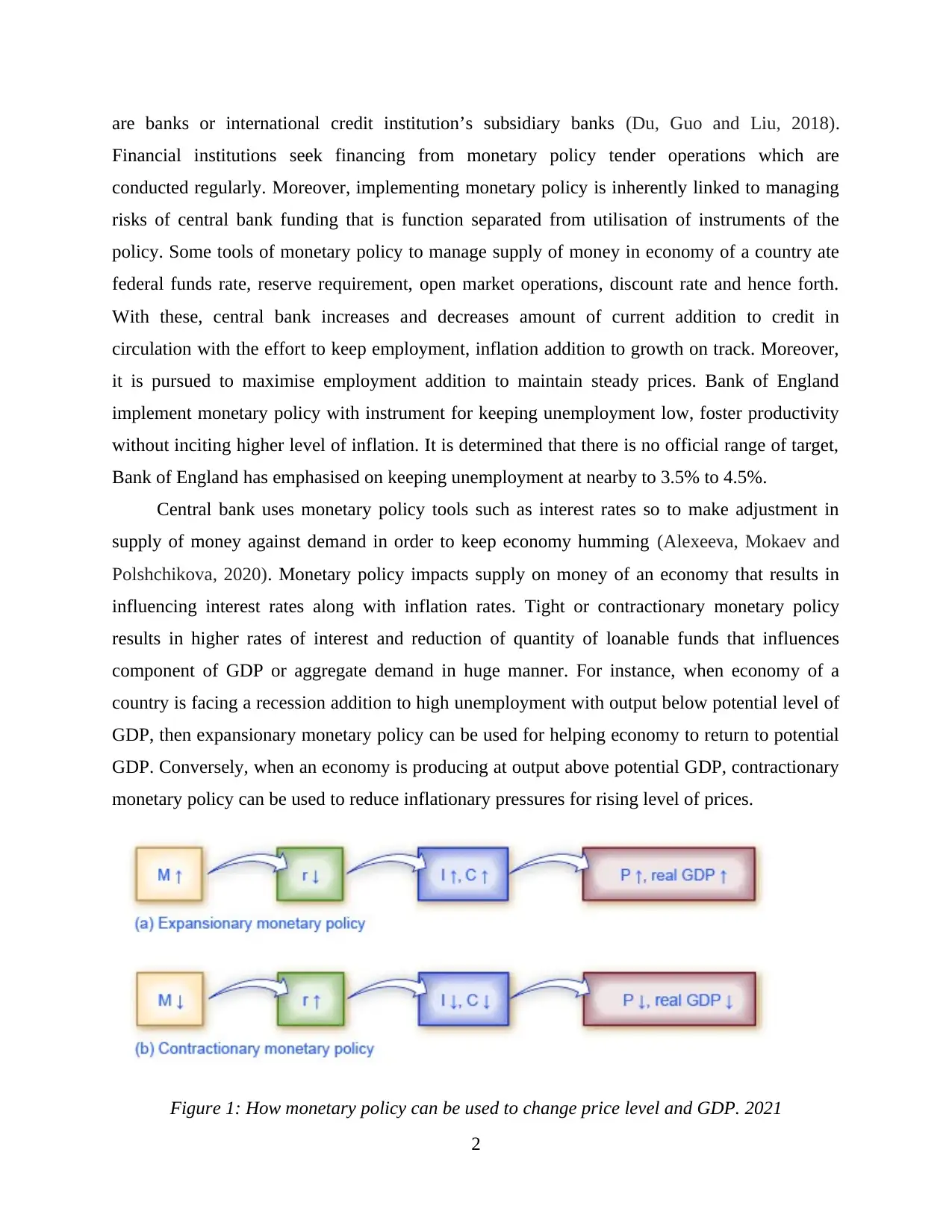
are banks or international credit institution’s subsidiary banks (Du, Guo and Liu, 2018).
Financial institutions seek financing from monetary policy tender operations which are
conducted regularly. Moreover, implementing monetary policy is inherently linked to managing
risks of central bank funding that is function separated from utilisation of instruments of the
policy. Some tools of monetary policy to manage supply of money in economy of a country ate
federal funds rate, reserve requirement, open market operations, discount rate and hence forth.
With these, central bank increases and decreases amount of current addition to credit in
circulation with the effort to keep employment, inflation addition to growth on track. Moreover,
it is pursued to maximise employment addition to maintain steady prices. Bank of England
implement monetary policy with instrument for keeping unemployment low, foster productivity
without inciting higher level of inflation. It is determined that there is no official range of target,
Bank of England has emphasised on keeping unemployment at nearby to 3.5% to 4.5%.
Central bank uses monetary policy tools such as interest rates so to make adjustment in
supply of money against demand in order to keep economy humming (Alexeeva, Mokaev and
Polshchikova, 2020). Monetary policy impacts supply on money of an economy that results in
influencing interest rates along with inflation rates. Tight or contractionary monetary policy
results in higher rates of interest and reduction of quantity of loanable funds that influences
component of GDP or aggregate demand in huge manner. For instance, when economy of a
country is facing a recession addition to high unemployment with output below potential level of
GDP, then expansionary monetary policy can be used for helping economy to return to potential
GDP. Conversely, when an economy is producing at output above potential GDP, contractionary
monetary policy can be used to reduce inflationary pressures for rising level of prices.
Figure 1: How monetary policy can be used to change price level and GDP. 2021
2
Financial institutions seek financing from monetary policy tender operations which are
conducted regularly. Moreover, implementing monetary policy is inherently linked to managing
risks of central bank funding that is function separated from utilisation of instruments of the
policy. Some tools of monetary policy to manage supply of money in economy of a country ate
federal funds rate, reserve requirement, open market operations, discount rate and hence forth.
With these, central bank increases and decreases amount of current addition to credit in
circulation with the effort to keep employment, inflation addition to growth on track. Moreover,
it is pursued to maximise employment addition to maintain steady prices. Bank of England
implement monetary policy with instrument for keeping unemployment low, foster productivity
without inciting higher level of inflation. It is determined that there is no official range of target,
Bank of England has emphasised on keeping unemployment at nearby to 3.5% to 4.5%.
Central bank uses monetary policy tools such as interest rates so to make adjustment in
supply of money against demand in order to keep economy humming (Alexeeva, Mokaev and
Polshchikova, 2020). Monetary policy impacts supply on money of an economy that results in
influencing interest rates along with inflation rates. Tight or contractionary monetary policy
results in higher rates of interest and reduction of quantity of loanable funds that influences
component of GDP or aggregate demand in huge manner. For instance, when economy of a
country is facing a recession addition to high unemployment with output below potential level of
GDP, then expansionary monetary policy can be used for helping economy to return to potential
GDP. Conversely, when an economy is producing at output above potential GDP, contractionary
monetary policy can be used to reduce inflationary pressures for rising level of prices.
Figure 1: How monetary policy can be used to change price level and GDP. 2021
2
Paraphrase This Document
Need a fresh take? Get an instant paraphrase of this document with our AI Paraphraser
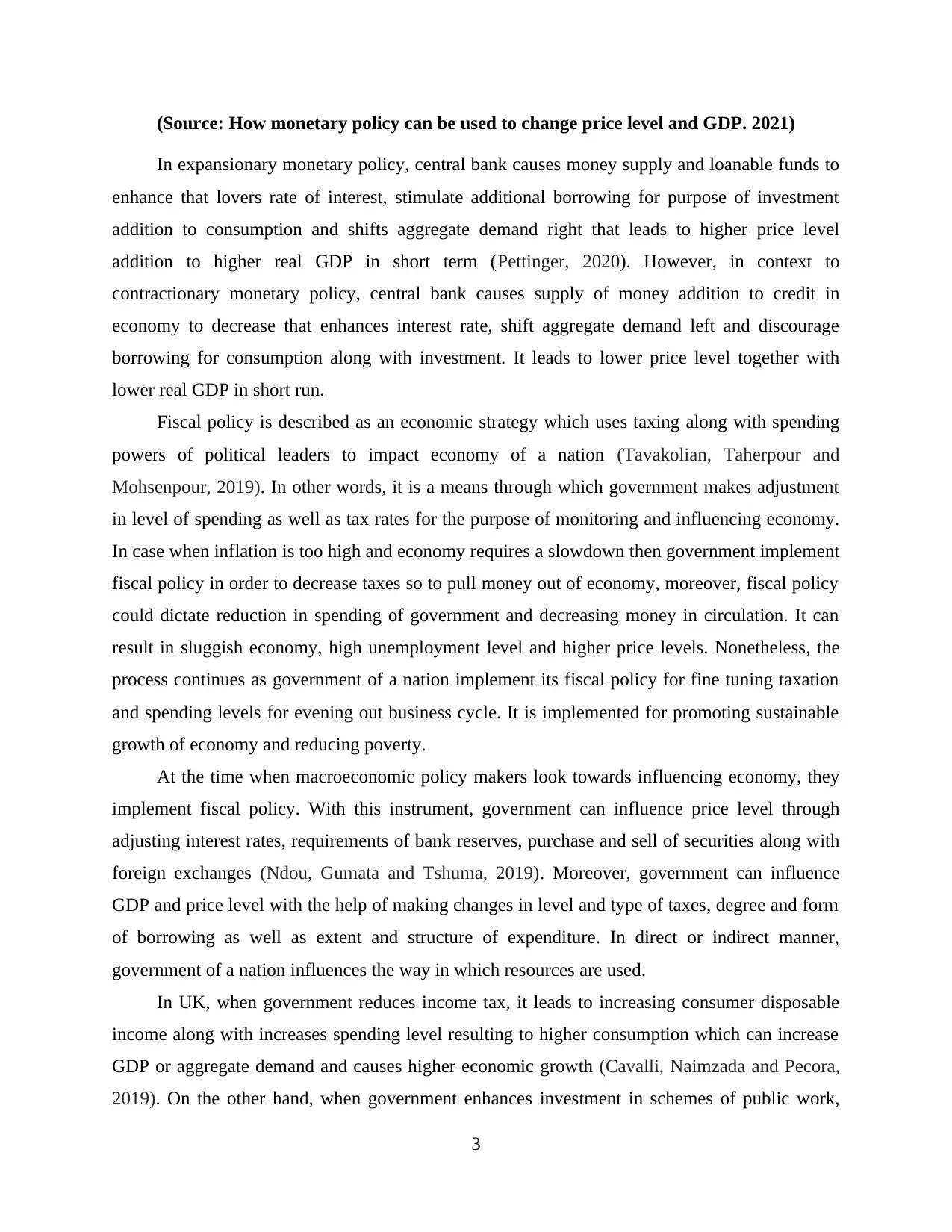
(Source: How monetary policy can be used to change price level and GDP. 2021)
In expansionary monetary policy, central bank causes money supply and loanable funds to
enhance that lovers rate of interest, stimulate additional borrowing for purpose of investment
addition to consumption and shifts aggregate demand right that leads to higher price level
addition to higher real GDP in short term (Pettinger, 2020). However, in context to
contractionary monetary policy, central bank causes supply of money addition to credit in
economy to decrease that enhances interest rate, shift aggregate demand left and discourage
borrowing for consumption along with investment. It leads to lower price level together with
lower real GDP in short run.
Fiscal policy is described as an economic strategy which uses taxing along with spending
powers of political leaders to impact economy of a nation (Tavakolian, Taherpour and
Mohsenpour, 2019). In other words, it is a means through which government makes adjustment
in level of spending as well as tax rates for the purpose of monitoring and influencing economy.
In case when inflation is too high and economy requires a slowdown then government implement
fiscal policy in order to decrease taxes so to pull money out of economy, moreover, fiscal policy
could dictate reduction in spending of government and decreasing money in circulation. It can
result in sluggish economy, high unemployment level and higher price levels. Nonetheless, the
process continues as government of a nation implement its fiscal policy for fine tuning taxation
and spending levels for evening out business cycle. It is implemented for promoting sustainable
growth of economy and reducing poverty.
At the time when macroeconomic policy makers look towards influencing economy, they
implement fiscal policy. With this instrument, government can influence price level through
adjusting interest rates, requirements of bank reserves, purchase and sell of securities along with
foreign exchanges (Ndou, Gumata and Tshuma, 2019). Moreover, government can influence
GDP and price level with the help of making changes in level and type of taxes, degree and form
of borrowing as well as extent and structure of expenditure. In direct or indirect manner,
government of a nation influences the way in which resources are used.
In UK, when government reduces income tax, it leads to increasing consumer disposable
income along with increases spending level resulting to higher consumption which can increase
GDP or aggregate demand and causes higher economic growth (Cavalli, Naimzada and Pecora,
2019). On the other hand, when government enhances investment in schemes of public work,
3
In expansionary monetary policy, central bank causes money supply and loanable funds to
enhance that lovers rate of interest, stimulate additional borrowing for purpose of investment
addition to consumption and shifts aggregate demand right that leads to higher price level
addition to higher real GDP in short term (Pettinger, 2020). However, in context to
contractionary monetary policy, central bank causes supply of money addition to credit in
economy to decrease that enhances interest rate, shift aggregate demand left and discourage
borrowing for consumption along with investment. It leads to lower price level together with
lower real GDP in short run.
Fiscal policy is described as an economic strategy which uses taxing along with spending
powers of political leaders to impact economy of a nation (Tavakolian, Taherpour and
Mohsenpour, 2019). In other words, it is a means through which government makes adjustment
in level of spending as well as tax rates for the purpose of monitoring and influencing economy.
In case when inflation is too high and economy requires a slowdown then government implement
fiscal policy in order to decrease taxes so to pull money out of economy, moreover, fiscal policy
could dictate reduction in spending of government and decreasing money in circulation. It can
result in sluggish economy, high unemployment level and higher price levels. Nonetheless, the
process continues as government of a nation implement its fiscal policy for fine tuning taxation
and spending levels for evening out business cycle. It is implemented for promoting sustainable
growth of economy and reducing poverty.
At the time when macroeconomic policy makers look towards influencing economy, they
implement fiscal policy. With this instrument, government can influence price level through
adjusting interest rates, requirements of bank reserves, purchase and sell of securities along with
foreign exchanges (Ndou, Gumata and Tshuma, 2019). Moreover, government can influence
GDP and price level with the help of making changes in level and type of taxes, degree and form
of borrowing as well as extent and structure of expenditure. In direct or indirect manner,
government of a nation influences the way in which resources are used.
In UK, when government reduces income tax, it leads to increasing consumer disposable
income along with increases spending level resulting to higher consumption which can increase
GDP or aggregate demand and causes higher economic growth (Cavalli, Naimzada and Pecora,
2019). On the other hand, when government enhances investment in schemes of public work,
3
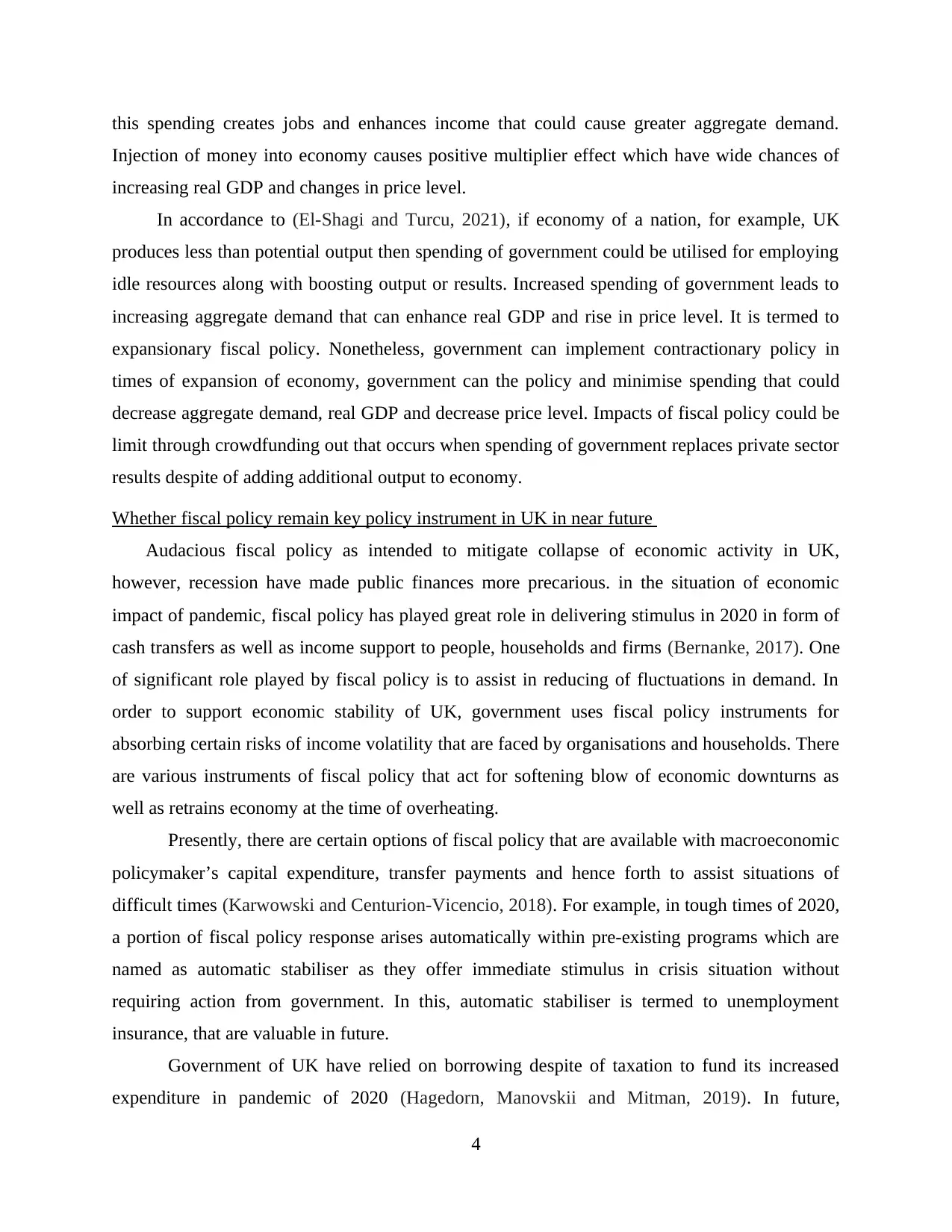
this spending creates jobs and enhances income that could cause greater aggregate demand.
Injection of money into economy causes positive multiplier effect which have wide chances of
increasing real GDP and changes in price level.
In accordance to (El-Shagi and Turcu, 2021), if economy of a nation, for example, UK
produces less than potential output then spending of government could be utilised for employing
idle resources along with boosting output or results. Increased spending of government leads to
increasing aggregate demand that can enhance real GDP and rise in price level. It is termed to
expansionary fiscal policy. Nonetheless, government can implement contractionary policy in
times of expansion of economy, government can the policy and minimise spending that could
decrease aggregate demand, real GDP and decrease price level. Impacts of fiscal policy could be
limit through crowdfunding out that occurs when spending of government replaces private sector
results despite of adding additional output to economy.
Whether fiscal policy remain key policy instrument in UK in near future
Audacious fiscal policy as intended to mitigate collapse of economic activity in UK,
however, recession have made public finances more precarious. in the situation of economic
impact of pandemic, fiscal policy has played great role in delivering stimulus in 2020 in form of
cash transfers as well as income support to people, households and firms (Bernanke, 2017). One
of significant role played by fiscal policy is to assist in reducing of fluctuations in demand. In
order to support economic stability of UK, government uses fiscal policy instruments for
absorbing certain risks of income volatility that are faced by organisations and households. There
are various instruments of fiscal policy that act for softening blow of economic downturns as
well as retrains economy at the time of overheating.
Presently, there are certain options of fiscal policy that are available with macroeconomic
policymaker’s capital expenditure, transfer payments and hence forth to assist situations of
difficult times (Karwowski and Centurion-Vicencio, 2018). For example, in tough times of 2020,
a portion of fiscal policy response arises automatically within pre-existing programs which are
named as automatic stabiliser as they offer immediate stimulus in crisis situation without
requiring action from government. In this, automatic stabiliser is termed to unemployment
insurance, that are valuable in future.
Government of UK have relied on borrowing despite of taxation to fund its increased
expenditure in pandemic of 2020 (Hagedorn, Manovskii and Mitman, 2019). In future,
4
Injection of money into economy causes positive multiplier effect which have wide chances of
increasing real GDP and changes in price level.
In accordance to (El-Shagi and Turcu, 2021), if economy of a nation, for example, UK
produces less than potential output then spending of government could be utilised for employing
idle resources along with boosting output or results. Increased spending of government leads to
increasing aggregate demand that can enhance real GDP and rise in price level. It is termed to
expansionary fiscal policy. Nonetheless, government can implement contractionary policy in
times of expansion of economy, government can the policy and minimise spending that could
decrease aggregate demand, real GDP and decrease price level. Impacts of fiscal policy could be
limit through crowdfunding out that occurs when spending of government replaces private sector
results despite of adding additional output to economy.
Whether fiscal policy remain key policy instrument in UK in near future
Audacious fiscal policy as intended to mitigate collapse of economic activity in UK,
however, recession have made public finances more precarious. in the situation of economic
impact of pandemic, fiscal policy has played great role in delivering stimulus in 2020 in form of
cash transfers as well as income support to people, households and firms (Bernanke, 2017). One
of significant role played by fiscal policy is to assist in reducing of fluctuations in demand. In
order to support economic stability of UK, government uses fiscal policy instruments for
absorbing certain risks of income volatility that are faced by organisations and households. There
are various instruments of fiscal policy that act for softening blow of economic downturns as
well as retrains economy at the time of overheating.
Presently, there are certain options of fiscal policy that are available with macroeconomic
policymaker’s capital expenditure, transfer payments and hence forth to assist situations of
difficult times (Karwowski and Centurion-Vicencio, 2018). For example, in tough times of 2020,
a portion of fiscal policy response arises automatically within pre-existing programs which are
named as automatic stabiliser as they offer immediate stimulus in crisis situation without
requiring action from government. In this, automatic stabiliser is termed to unemployment
insurance, that are valuable in future.
Government of UK have relied on borrowing despite of taxation to fund its increased
expenditure in pandemic of 2020 (Hagedorn, Manovskii and Mitman, 2019). In future,
4
⊘ This is a preview!⊘
Do you want full access?
Subscribe today to unlock all pages.

Trusted by 1+ million students worldwide
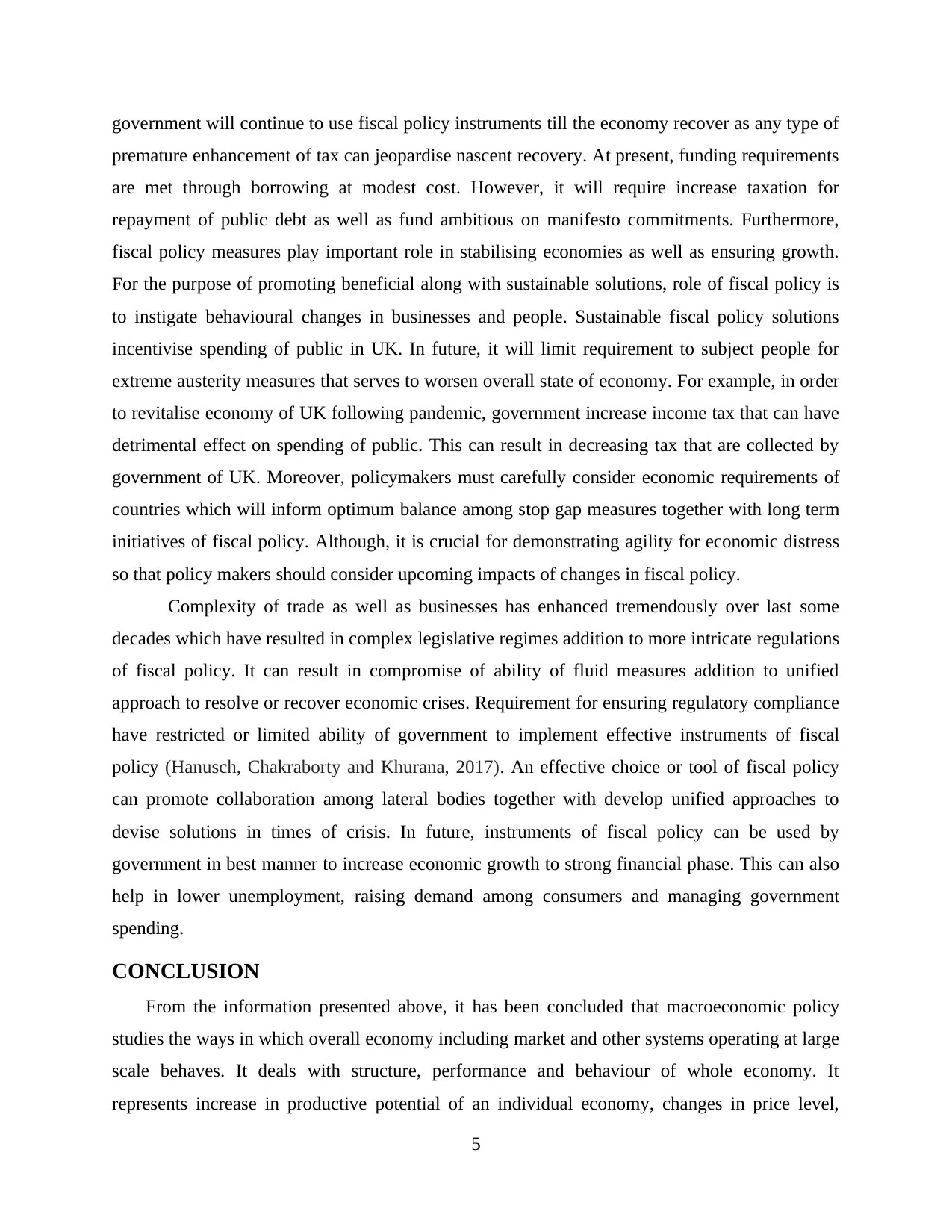
government will continue to use fiscal policy instruments till the economy recover as any type of
premature enhancement of tax can jeopardise nascent recovery. At present, funding requirements
are met through borrowing at modest cost. However, it will require increase taxation for
repayment of public debt as well as fund ambitious on manifesto commitments. Furthermore,
fiscal policy measures play important role in stabilising economies as well as ensuring growth.
For the purpose of promoting beneficial along with sustainable solutions, role of fiscal policy is
to instigate behavioural changes in businesses and people. Sustainable fiscal policy solutions
incentivise spending of public in UK. In future, it will limit requirement to subject people for
extreme austerity measures that serves to worsen overall state of economy. For example, in order
to revitalise economy of UK following pandemic, government increase income tax that can have
detrimental effect on spending of public. This can result in decreasing tax that are collected by
government of UK. Moreover, policymakers must carefully consider economic requirements of
countries which will inform optimum balance among stop gap measures together with long term
initiatives of fiscal policy. Although, it is crucial for demonstrating agility for economic distress
so that policy makers should consider upcoming impacts of changes in fiscal policy.
Complexity of trade as well as businesses has enhanced tremendously over last some
decades which have resulted in complex legislative regimes addition to more intricate regulations
of fiscal policy. It can result in compromise of ability of fluid measures addition to unified
approach to resolve or recover economic crises. Requirement for ensuring regulatory compliance
have restricted or limited ability of government to implement effective instruments of fiscal
policy (Hanusch, Chakraborty and Khurana, 2017). An effective choice or tool of fiscal policy
can promote collaboration among lateral bodies together with develop unified approaches to
devise solutions in times of crisis. In future, instruments of fiscal policy can be used by
government in best manner to increase economic growth to strong financial phase. This can also
help in lower unemployment, raising demand among consumers and managing government
spending.
CONCLUSION
From the information presented above, it has been concluded that macroeconomic policy
studies the ways in which overall economy including market and other systems operating at large
scale behaves. It deals with structure, performance and behaviour of whole economy. It
represents increase in productive potential of an individual economy, changes in price level,
5
premature enhancement of tax can jeopardise nascent recovery. At present, funding requirements
are met through borrowing at modest cost. However, it will require increase taxation for
repayment of public debt as well as fund ambitious on manifesto commitments. Furthermore,
fiscal policy measures play important role in stabilising economies as well as ensuring growth.
For the purpose of promoting beneficial along with sustainable solutions, role of fiscal policy is
to instigate behavioural changes in businesses and people. Sustainable fiscal policy solutions
incentivise spending of public in UK. In future, it will limit requirement to subject people for
extreme austerity measures that serves to worsen overall state of economy. For example, in order
to revitalise economy of UK following pandemic, government increase income tax that can have
detrimental effect on spending of public. This can result in decreasing tax that are collected by
government of UK. Moreover, policymakers must carefully consider economic requirements of
countries which will inform optimum balance among stop gap measures together with long term
initiatives of fiscal policy. Although, it is crucial for demonstrating agility for economic distress
so that policy makers should consider upcoming impacts of changes in fiscal policy.
Complexity of trade as well as businesses has enhanced tremendously over last some
decades which have resulted in complex legislative regimes addition to more intricate regulations
of fiscal policy. It can result in compromise of ability of fluid measures addition to unified
approach to resolve or recover economic crises. Requirement for ensuring regulatory compliance
have restricted or limited ability of government to implement effective instruments of fiscal
policy (Hanusch, Chakraborty and Khurana, 2017). An effective choice or tool of fiscal policy
can promote collaboration among lateral bodies together with develop unified approaches to
devise solutions in times of crisis. In future, instruments of fiscal policy can be used by
government in best manner to increase economic growth to strong financial phase. This can also
help in lower unemployment, raising demand among consumers and managing government
spending.
CONCLUSION
From the information presented above, it has been concluded that macroeconomic policy
studies the ways in which overall economy including market and other systems operating at large
scale behaves. It deals with structure, performance and behaviour of whole economy. It
represents increase in productive potential of an individual economy, changes in price level,
5
Paraphrase This Document
Need a fresh take? Get an instant paraphrase of this document with our AI Paraphraser
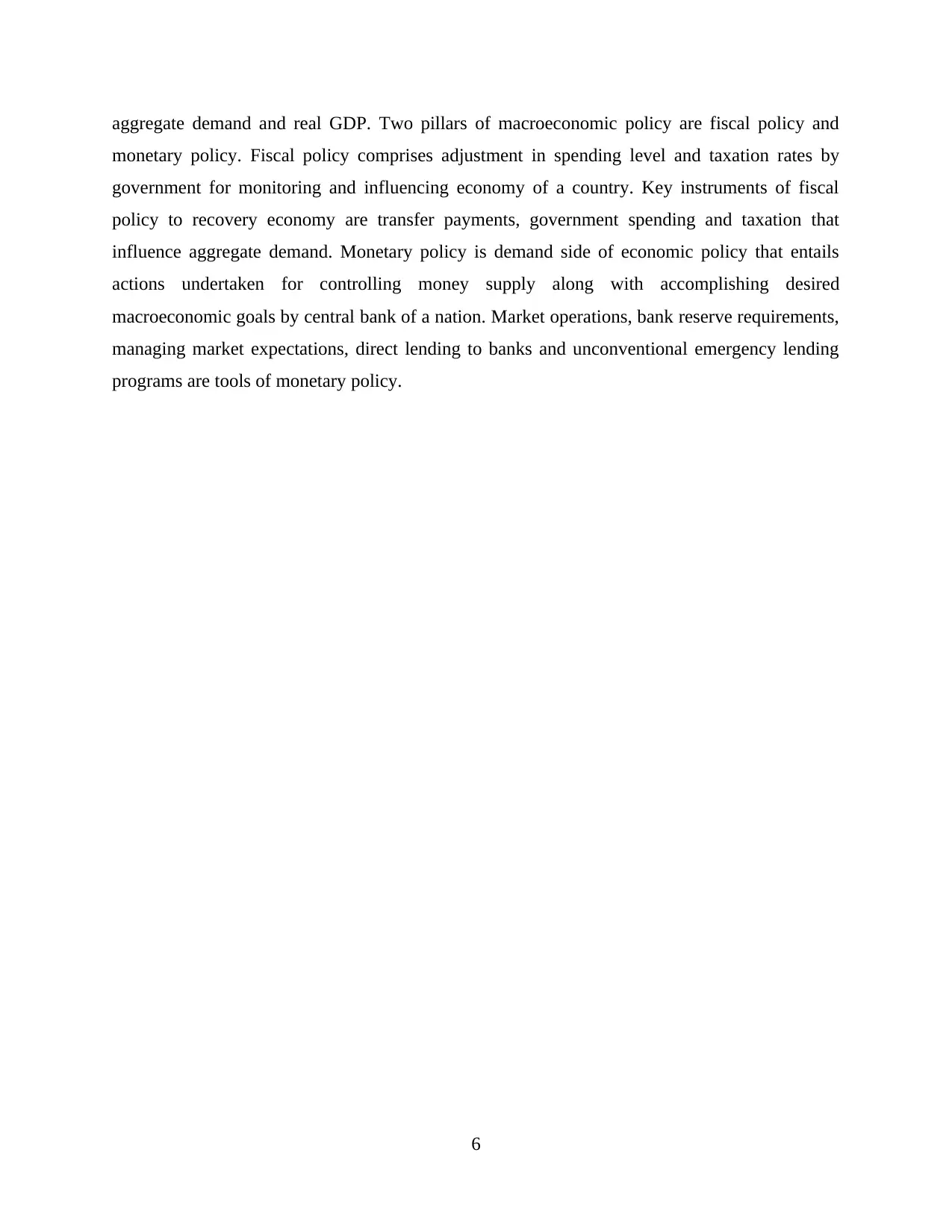
aggregate demand and real GDP. Two pillars of macroeconomic policy are fiscal policy and
monetary policy. Fiscal policy comprises adjustment in spending level and taxation rates by
government for monitoring and influencing economy of a country. Key instruments of fiscal
policy to recovery economy are transfer payments, government spending and taxation that
influence aggregate demand. Monetary policy is demand side of economic policy that entails
actions undertaken for controlling money supply along with accomplishing desired
macroeconomic goals by central bank of a nation. Market operations, bank reserve requirements,
managing market expectations, direct lending to banks and unconventional emergency lending
programs are tools of monetary policy.
6
monetary policy. Fiscal policy comprises adjustment in spending level and taxation rates by
government for monitoring and influencing economy of a country. Key instruments of fiscal
policy to recovery economy are transfer payments, government spending and taxation that
influence aggregate demand. Monetary policy is demand side of economic policy that entails
actions undertaken for controlling money supply along with accomplishing desired
macroeconomic goals by central bank of a nation. Market operations, bank reserve requirements,
managing market expectations, direct lending to banks and unconventional emergency lending
programs are tools of monetary policy.
6
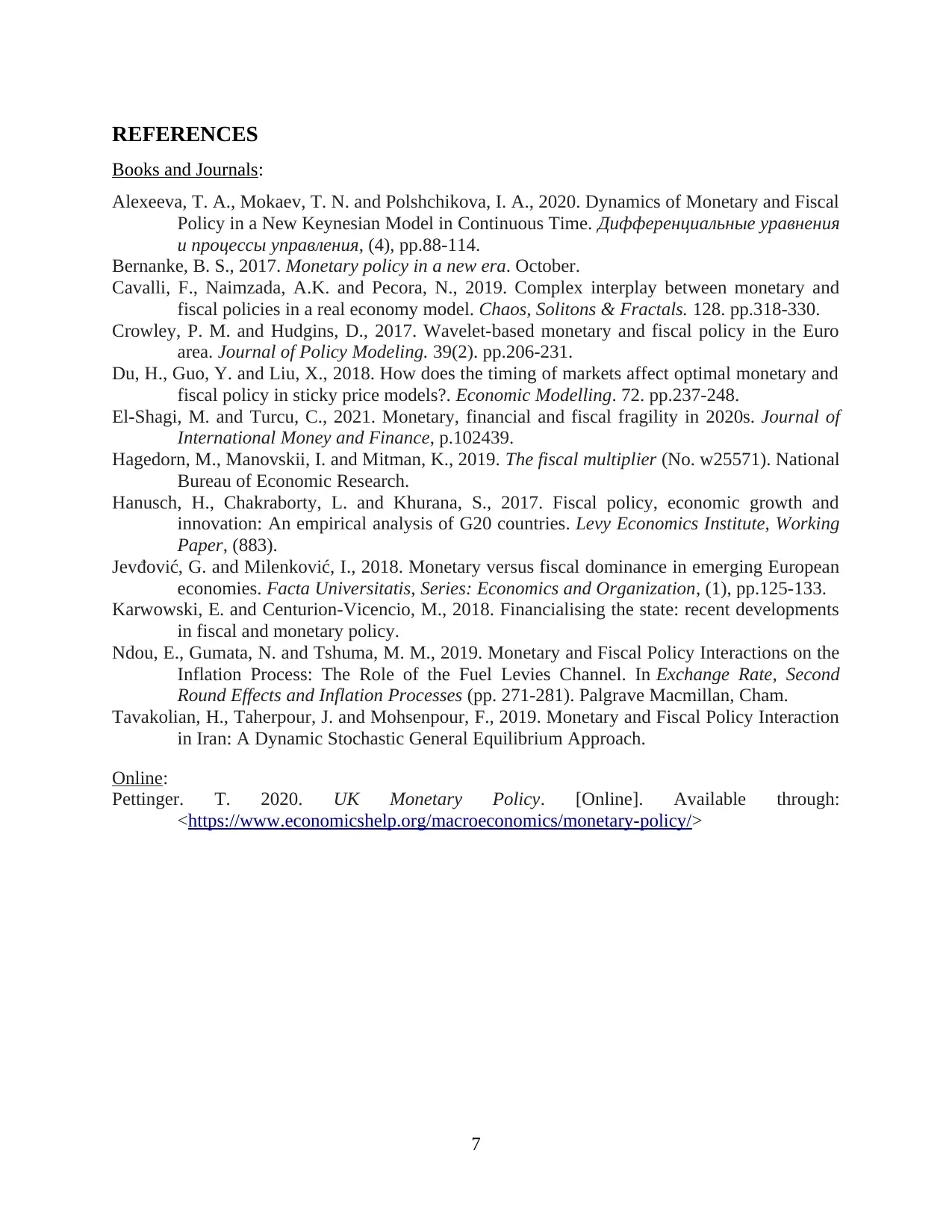
REFERENCES
Books and Journals:
Alexeeva, T. A., Mokaev, T. N. and Polshchikova, I. A., 2020. Dynamics of Monetary and Fiscal
Policy in a New Keynesian Model in Continuous Time. Дифференциальные уравнения
и процессы управления, (4), pp.88-114.
Bernanke, B. S., 2017. Monetary policy in a new era. October.
Cavalli, F., Naimzada, A.K. and Pecora, N., 2019. Complex interplay between monetary and
fiscal policies in a real economy model. Chaos, Solitons & Fractals. 128. pp.318-330.
Crowley, P. M. and Hudgins, D., 2017. Wavelet-based monetary and fiscal policy in the Euro
area. Journal of Policy Modeling. 39(2). pp.206-231.
Du, H., Guo, Y. and Liu, X., 2018. How does the timing of markets affect optimal monetary and
fiscal policy in sticky price models?. Economic Modelling. 72. pp.237-248.
El-Shagi, M. and Turcu, C., 2021. Monetary, financial and fiscal fragility in 2020s. Journal of
International Money and Finance, p.102439.
Hagedorn, M., Manovskii, I. and Mitman, K., 2019. The fiscal multiplier (No. w25571). National
Bureau of Economic Research.
Hanusch, H., Chakraborty, L. and Khurana, S., 2017. Fiscal policy, economic growth and
innovation: An empirical analysis of G20 countries. Levy Economics Institute, Working
Paper, (883).
Jevđović, G. and Milenković, I., 2018. Monetary versus fiscal dominance in emerging European
economies. Facta Universitatis, Series: Economics and Organization, (1), pp.125-133.
Karwowski, E. and Centurion-Vicencio, M., 2018. Financialising the state: recent developments
in fiscal and monetary policy.
Ndou, E., Gumata, N. and Tshuma, M. M., 2019. Monetary and Fiscal Policy Interactions on the
Inflation Process: The Role of the Fuel Levies Channel. In Exchange Rate, Second
Round Effects and Inflation Processes (pp. 271-281). Palgrave Macmillan, Cham.
Tavakolian, H., Taherpour, J. and Mohsenpour, F., 2019. Monetary and Fiscal Policy Interaction
in Iran: A Dynamic Stochastic General Equilibrium Approach.
Online:
Pettinger. T. 2020. UK Monetary Policy. [Online]. Available through:
<https://www.economicshelp.org/macroeconomics/monetary-policy/>
7
Books and Journals:
Alexeeva, T. A., Mokaev, T. N. and Polshchikova, I. A., 2020. Dynamics of Monetary and Fiscal
Policy in a New Keynesian Model in Continuous Time. Дифференциальные уравнения
и процессы управления, (4), pp.88-114.
Bernanke, B. S., 2017. Monetary policy in a new era. October.
Cavalli, F., Naimzada, A.K. and Pecora, N., 2019. Complex interplay between monetary and
fiscal policies in a real economy model. Chaos, Solitons & Fractals. 128. pp.318-330.
Crowley, P. M. and Hudgins, D., 2017. Wavelet-based monetary and fiscal policy in the Euro
area. Journal of Policy Modeling. 39(2). pp.206-231.
Du, H., Guo, Y. and Liu, X., 2018. How does the timing of markets affect optimal monetary and
fiscal policy in sticky price models?. Economic Modelling. 72. pp.237-248.
El-Shagi, M. and Turcu, C., 2021. Monetary, financial and fiscal fragility in 2020s. Journal of
International Money and Finance, p.102439.
Hagedorn, M., Manovskii, I. and Mitman, K., 2019. The fiscal multiplier (No. w25571). National
Bureau of Economic Research.
Hanusch, H., Chakraborty, L. and Khurana, S., 2017. Fiscal policy, economic growth and
innovation: An empirical analysis of G20 countries. Levy Economics Institute, Working
Paper, (883).
Jevđović, G. and Milenković, I., 2018. Monetary versus fiscal dominance in emerging European
economies. Facta Universitatis, Series: Economics and Organization, (1), pp.125-133.
Karwowski, E. and Centurion-Vicencio, M., 2018. Financialising the state: recent developments
in fiscal and monetary policy.
Ndou, E., Gumata, N. and Tshuma, M. M., 2019. Monetary and Fiscal Policy Interactions on the
Inflation Process: The Role of the Fuel Levies Channel. In Exchange Rate, Second
Round Effects and Inflation Processes (pp. 271-281). Palgrave Macmillan, Cham.
Tavakolian, H., Taherpour, J. and Mohsenpour, F., 2019. Monetary and Fiscal Policy Interaction
in Iran: A Dynamic Stochastic General Equilibrium Approach.
Online:
Pettinger. T. 2020. UK Monetary Policy. [Online]. Available through:
<https://www.economicshelp.org/macroeconomics/monetary-policy/>
7
⊘ This is a preview!⊘
Do you want full access?
Subscribe today to unlock all pages.

Trusted by 1+ million students worldwide
1 out of 9
Related Documents
Your All-in-One AI-Powered Toolkit for Academic Success.
+13062052269
info@desklib.com
Available 24*7 on WhatsApp / Email
![[object Object]](/_next/static/media/star-bottom.7253800d.svg)
Unlock your academic potential
Copyright © 2020–2025 A2Z Services. All Rights Reserved. Developed and managed by ZUCOL.





